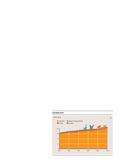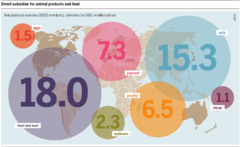Meat Atlas
 | |
| Original title | Der Fleischatlas |
|---|---|
| Country | Germany |
| Language | English and German |
| Subject | Meat production, intensive animal agriculture, environment |
| Publisher | Heinrich Böll Foundation and Friends of the Earth Europe |
Publication date | January 2014 |
| Media type | Online / print |
| Pages | 68 |

Meat Atlas (Der Fleischatlas) is an annual report, published by the Heinrich Böll Foundation and Friends of the Earth Europe, on the methods and impact of industrial animal agriculture.[1] Consisting of 27 short essays by different authors, the report aims to inform consumers about the impact of meat consumption on global poverty, climate change, animal welfare, biodiversity, and the migration of workers.[2]
Meat Atlas was first published in German in 2013, and in German and English in 2014, both under a Creative Commons license (CC BY-SA 3.0). The executive editors are Christine Chemnitz of the Heinrich Böll Foundation and Stanka Becheva of Friends of the Earth Europe.[3]
Synopsis
Overview
Magda Stoczkiewicz, director of Friends of the Earth Europe, argues in the report that "[n]othing epitomizes what is wrong with our food and farming more than the livestock sector and the quest for cheap and plentiful meat."
She writes that livestock farming is one of the biggest greenhouse gas emitters, and is responsible for health pandemics and the use of a significant percentage of the world's grain and water.[4] According to the report, based on figures from the United Nations' Food and Agriculture Organization, the production of 1 kg (2.2 lb) of beef requires 15,455 litres of water (32,662 pints, or 110 bathtubs), cheese 5,000 litres, rice 3,400 litres and carrots 131 litres.[5] Over 75 kg (165 lb) of meat is consumed in the United States per person per year, 60 kg in Germany, 38 kg in China, and under 20 kg in Africa.[1]
The report states that animals are kept in cramped conditions, in artificial light, and fed antibiotics and hormones to ward off disease and speed up growth cheaply.[4] Pigs can reach their market weight with 10–15 percent less food if they are kept on antibiotics, but overuse has created antibiotic-resistant bacteria, so-called "superbugs."[5] Stoczkiewicz argues instead in favour of sustainable farming, where animals are kept in much smaller numbers and are allowed to graze freely, with farmers growing their own crops to feed them.[4]
Meat production


Through mergers and acquisitions across borders and species, meat production is handled by an ever-diminishing number of large companies.[6] The report lists the world's top-ten meat producers (see right), calculated by total food sales in the years 2011–2013.[7]
JBS, headquartered in São Paulo, Brazil, heads the list. The company's 2012 revenue of $38.7 billion exceeded the gross domestic product of Barbados, Iceland, Mauritius and Zimbabwe combined.[5] JBS is followed by Tyson Foods, Cargill, BRF, Vion, Nippon Meat Packers, Smithfield Foods, Marfrig, and Danish Crown. Just ten companies kill 88 percent of pigs.[7]
Because profit margins are tight, companies aim for greater efficiency and lower costs, with as much profit as possible from "field to fork."[8] According to the report, JBS can accommodate a daily slaughter of 12 million birds, 85,000 head of cattle and 70,000 pigs, the produce of which is sold in 150 countries.[9] Tyson Foods kills 42 million chickens, 350,000 pigs and 170,000 head of cattle every week.[10]
The kind of environment in which this occurs means that pathogens can spread easily, both during slaughter and transport.[7] For the animals it means increased cruelty because of long journeys to slaughterhouses, inadequate stunning, and violence from stressed workers. For the workers, it means low wages, a noisy and highly stressful working environment, and long shifts spent making high-speed repetitive movements with dangerous equipment and frightened animals. For the consumer, it severs the relationship between the animals and the end product on the supermarket shelf.[11]
 Worldwide meat production
Worldwide meat production Numbers of birds killed
Numbers of birds killed Direct subsidies for animal products and feed (in OECD countries)
Direct subsidies for animal products and feed (in OECD countries) Estimated chicken consumption per person, 2012, in kilograms,
Estimated chicken consumption per person, 2012, in kilograms, Animal genetics industry: the Big Seven global breeders
Animal genetics industry: the Big Seven global breeders
Accompanying events
The release of the Meat Atlas in January coincides with the Berlin International Green Week and demonstrations in Berlin themed We are fed up! against industrial livestock production and for more sustainable farming.[12]
References
- 1 2 Damien McGuinness, "'Meat Atlas' charts a changing world of meat eaters", BBC News, 9 January 2014.
- ↑ Barbara Unmüßig, Introduction, Meat Atlas, 2014, p. 6.
- ↑ Meat Atlas, 2014, back cover.
- 1 2 3 Meat Atlas, 2014, p. 7.
- 1 2 3 Mona Chalabi, "Meat atlas shows Latin America has become a soybean empire", The Guardian, 9 January 2014.
- ↑ Meat Atlas, 2014, p. 12.
- 1 2 3 Meat Atlas, 2014, pp. 13–14.
- ↑ Meat Atlas, 2014, pp. 12, 14.
- ↑ Meat Atlas, 2014, p. 12: "These figures give us an idea of what JBS's size means on the ground or at the slaughterhouse: its worldwide capacities can slaughter 85,000 head of cattle, 70,000 pigs, and 12 million birds. Every day. The meat is distributed in 150 countries as soon as the carcasses are 'disassembled', i.e. when the flesh is separated from the bone."
- Also see Luciana Magalhaes and Rogerio Jelmayer, "With Purchase, Brazil's JBS Takes Leading Position in Global Poultry Market", Wall Street Journal, 10 June 2013: "JBS entered the chicken business in Brazil last year, and it also controls U.S. chicken producer Pilgrim's Pride Corp (PPC). With the acquisition, JBS's slaughter capacity will rise to around 12 million birds a day."
- Bryan Gruley and Lucia Kassai, "Brazilian Meatpacker JBS Wrangles the U.S. Beef Industry", Business Week, 19 September 2013: "In June [2013], JBS said it would assume $2.74 billion of debt to acquire the Seara poultry and processed-food business from Marfrig Alimentos (MRFG3:BZ) of Brazil. When that deal closes, JBS will have $50 billion in annual revenue and the daily capacity to slaughter 85,000 head of cattle, 70,000 hogs, and 12 million birds, about 30 percent of which will be exported to more than 150 countries."
- ↑ Meat Atlas, 2014, p. 14.
- ↑ Meat Atlas, 2014, pp. 14–15.
- ↑ Friends of the Earth Europe, We are fed up: 30,000 march in Berlin, 19 January 2014
Further reading
- Meat Atlas, Friends of the Earth, download Meat Atlas as pdf; download summary and policy demands as pdf
- Meat Atlas, Heinrich Böll Foundation
- Alexandra Endres, "Fleischatlas – Unser täglich Hormonfleisch", Die Zeit, 9 January 2014.
- Shefali Sharma, "Germans speaking out against industrial meat and agriculture", Institute for Agriculture and Trade Policy, 9 January 2014.
- "Fleischatlas 2014: Trog, Teller und Sonntagsbraten", Frankfurter Allgemeine Zeitung, 9 January 2014.
- "Fleischatlas 2014: Pro und Contra Fleisch als Lebensmittel", WDR 5, 9 January 2014.
- "Alarm over soaring world meat consumption", Deutsche Welle, 9 January 2014.